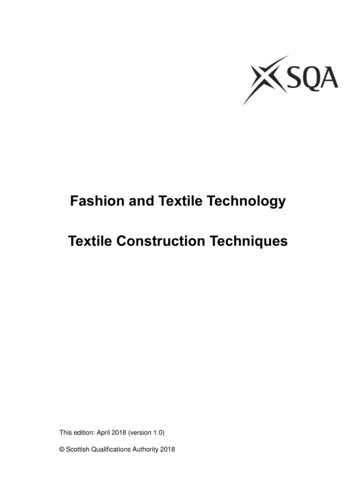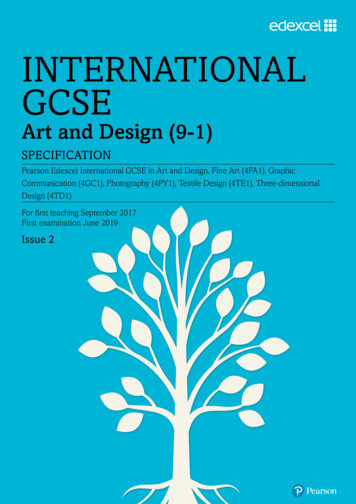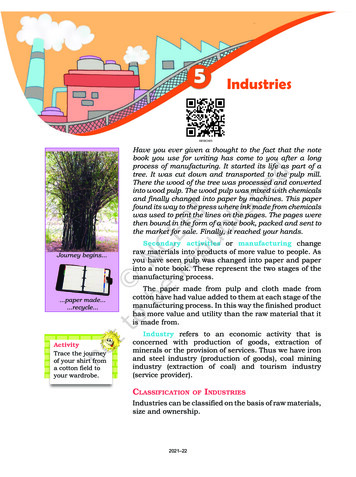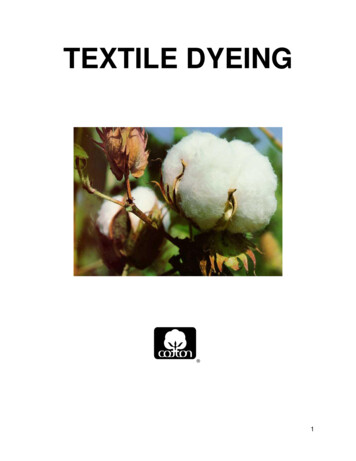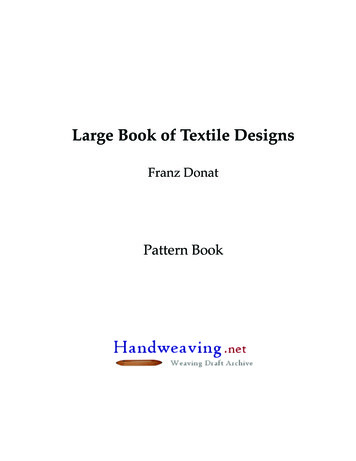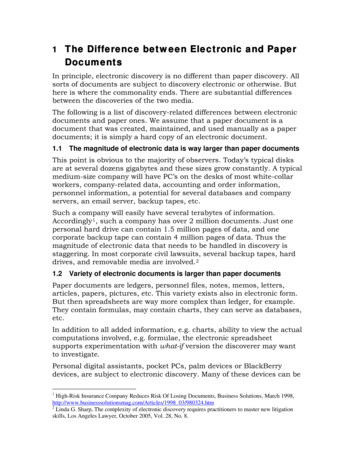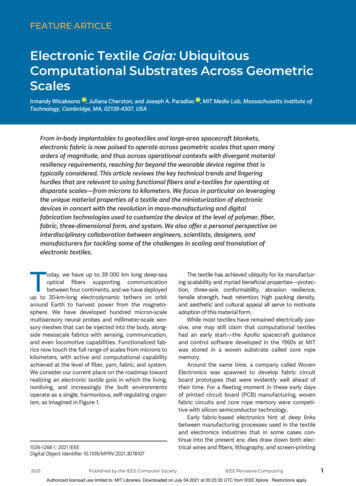
Transcription
This article has been accepted for inclusion in a future issue of this journal. Content is final as presented, with the exception of pagination.FEATURE ARTICLEElectronic Textile Gaia: UbiquitousComputational Substrates Across GeometricScalesIrmandy Wicaksono , Juliana Cherston, and Joseph A. ParadisoTechnology, Cambridge, MA, 02139-4307, USA, MIT Media Lab, Massachusetts Institute ofFrom in-body implantables to geotextiles and large-area spacecraft blankets,electronic fabric is now poised to operate across geometric scales that span manyorders of magnitude, and thus across operational contexts with divergent materialresiliency requirements, reaching far beyond the wearable device regime that istypically considered. This article reviews the key technical trends and lingeringhurdles that are relevant to using functional fibers and e-textiles for operating atdisparate scales—from microns to kilometers. We focus in particular on leveragingthe unique material properties of a textile and the miniaturization of electronicdevices in concert with the revolution in mass-manufacturing and digitalfabrication technologies used to customize the device at the level of polymer, fiber,fabric, three-dimensional form, and system. We also offer a personal perspective oninterdisciplinary collaboration between engineers, scientists, designers, andmanufacturers for tackling some of the challenges in scaling and translation ofelectronic textiles.Today, we have up to 39 000 km long deep-seaoptical fibers supporting communicationbetween four continents, and we have deployedup to 30-km-long electrodynamic tethers on orbitaround Earth to harvest power from the magnetosphere. We have developed hundred micron-scalemultisensory neural probes and millimeter-scale sensory meshes that can be injected into the body, alongside mesoscale fabrics with sensing, communication,and even locomotive capabilities. Functionalized fabrics now touch the full range of scales from microns tokilometers, with active and computational capabilityachieved at the level of fiber, yarn, fabric, and system.We consider our current place on the roadmap towardrealizing an electronic textile gaia in which the living,nonliving, and increasingly the built environmentsoperate as a single, harmonious, self-regulating organism, as imagined in Figure 1.1536-1268 ß 2021 IEEEDigital Object Identifier 10.1109/MPRV.2021.30781072021Published by the IEEE Computer SocietyThe textile has achieved ubiquity for its manufacturing scalability and myriad beneficial properties—protection, three-axis conformability, abrasion resilience,tensile strength, heat retention, high packing density,and aesthetic and cultural appeal all serve to motivateadoption of this material form.While most textiles have remained electrically passive, one may still claim that computational textileshad an early start—the Apollo spacecraft guidanceand control software developed in the 1960s at MITwas stored in a woven substrate called core ropememory.Around the same time, a company called WovenElectronics was spawned to develop fabric circuitboard prototypes that were evidently well ahead oftheir time. For a fleeting moment in these early daysof printed circuit board (PCB) manufacturing, wovenfabric circuits and core rope memory were competitive with silicon semiconductor technology.Early fabric-based electronics hint at deep linksbetween manufacturing processes used in the textileand electronics industries that in some cases continue into the present era: dies draw down both electrical wires and fibers, lithography, and screen-printingIEEE Pervasive ComputingAuthorized licensed use limited to: MIT Libraries. Downloaded on July 04,2021 at 00:23:33 UTC from IEEE Xplore. Restrictions apply.1
This article has been accepted for inclusion in a future issue of this journal. Content is final as presented, with the exception of pagination.FEATURE ARTICLEFIGURE 1. Imagined Electronic Textile Gaia, in which fabrics and fibers take on electrically active functions in-body, on-body,across the built environment, submerged within landscapes, seascapes, and extending out to our orbital and even our interplanetary infrastructure. (Illustrated with the help of Franny Xi Wu).techniques pattern both printed circuits and fabricembellishments, and, as a historic example, punchcards originally developed for the Jacquard loomfound broad computational applications.Still, large-scale deployment of functional fibersand textiles remain isolated, and application scopesfor these devices highly specific. Bearing in mind Abelton, Knight, and Sussman’s Amorphous ComputingManifesto,1 which calls for ubiquitous, massively distributed computational bits with emergent order,2what will it take to realize sensory, computational, andactuated elements that sink into fabric substratesacross the in-body, on-body, and built environments?These substrates will be barely perceptible. In somecases they will be highly tuned for specialized environments and in other cases they will be highly multimodal and generalizable across scale and applicationcontext.A significant portion of prior art in the field of electronic textile (e-textile) design targets sensor-ladenIEEE Pervasive ComputingAuthorized licensed use limited to: MIT Libraries. Downloaded on July 04,2021 at 00:23:33 UTC from IEEE Xplore. Restrictions apply.2021
This article has been accepted for inclusion in a future issue of this journal. Content is final as presented, with the exception of pagination.FEATURE ARTICLEFIGURE 2. Hierarchical architecture and various structures of electronic textiles starting from fiber (1-D), yarn (1.5-D), fabric (2-D),fabric composite (3-D), to the end-product. Besides structural functionalization, we also show the material functionalizationstage at the fiber or fabric-level.wearables for health monitoring. Here, we focus onthe breadth of scale and operational contexts appropriate for fiber-like and mesh-like architectures. Wefirst review techniques for achieving electrical functionality at the level of fiber, yarn, and fabric. We thendescribe representative applications that cover thefull range of geometric scales, highlighting in particular the importance of manufacturing partnerships inearly research. Finally, we contextualize the textile asmerely one ubiquitous medium among many moreexotic substrates that are ripe for functionalization.ELECTRONIC TEXTILEINTEGRATION: FROM MICRO,MESO, TO MACROAs illustrated in Figure 2, the functionalization of textiles can take place at every dimension: 0-D (material),1-D (fiber), 2-D (fabric), 3-D (complex structures), and2021finally the end-product or system. In this article, wewill focus on electronic and electrically active materials, devices, and systems as means for integration andfunctionalization.Generally speaking, there are three main approachesused to develop e-textiles, ranging in complexityfrom highly specialized to widely accessible. The firstapproach is to grow computational fibers by depositingelectronic nanostructures on the surface or inside thefibers.For additional progress in miniaturization, werequire an advanced fabrication and manufacturingprocess that integrates microelectronics seamlesslywithin the 1-D fiber structure.The second technique is to electrically functionalize textiles with solution-based coating or printing ateither the fiber or fabric level. This technique can bequickly scaled using existing textile manufacturingand treatment processes. The third approach appliesIEEE Pervasive ComputingAuthorized licensed use limited to: MIT Libraries. Downloaded on July 04,2021 at 00:23:33 UTC from IEEE Xplore. Restrictions apply.3
This article has been accepted for inclusion in a future issue of this journal. Content is final as presented, with the exception of pagination.FEATURE ARTICLEtextile art practices such as knitting, embroidery, orsewing either by hand or machine.13 Sewing, for example, can be used to attach microelectronic devices orcircuits as appendages such as buttons, jewelry, pins,or embedded into textile pockets.21 It can also patternand integrate commercially available conductive orother electroactive fibers, yarns, or fabrics onto andinto garments, footwear, and other end-products.16Ultimately, it is the task of an engineer or systemintegrator to map the e-textile’s requisite function tothe forms achieved by these various textile manufacturing approaches.FiberSpinning is one of the most frequently applied methods for manufacturing fibers. Raw materials in a fluidstate, such as intrinsically conductive polymers, canbe added to the spinning precursors. Depending onthe spinning process, this base material is then meltedor submerged in a chemical bath and pumped underpressure through a spinneret. The spinneret containsmany small openings and a cooling mechanism toextrude and harden the polymers into long filaments.The output of this process is synthetic fiber with electrical functionality. Several efforts have blended fiberpolymer with silver nanoparticles (AgNP), silicon nanowires (AgNW), carbon black, carbon nanotubes (CNT),graphene, polyaniline, polypyrrole, and poly polystyrene sulfonate (PEDOT:PSS) via wet or dry-spinningmethods to develop conductive and resistive fibers asinterconnects or sensors.2 Their functional properties,morphology, and heterogeneity can be engineered tosensitively detect mechanical pressure, strain, temperature, humidity, pH, or specific chemical stimuli.Electrospinning, another approach that involves highvoltage polarization, has been demonstrated to produce piezoelectric nanogenerators by extrusion andbeta enhanced, poled polyvinylidene fluoride (PVDF)fibers. It is also possible to coat conductive polymersonto nonfunctional, synthetic, or naturally spun fibersusing postspinning processes such as in situ polymerization, dip-coating, electroless plating, vacuumplasma spraying, and physical vapor deposition.3 Inbundle drawing, a composite wire consisting of thousands of filaments from metal alloys or preforms suchas stainless steel, titanium, nickel, ferrous, and aluminum and sacrificial fillers is pulled through a die multiple times until reaching the final desired diameter. Thesacrificial fillers can then be dissolved through achemical process. Even though metallic fibers havebetter electrical performance, polymeric fibers aremore mechanically robust, lightweight, and flexible4than metallic fibers. Therefore, they can be more easilyintegrated into standard textile manufacturingprocesses.Preform drawing processes have also beenexplored to develop multimaterial and multifunctionalelectronic fibers (e-fibers) for a broad range of applications.4 For instance, widely available copper wires,optical fibers, as well as shape-memory alloy (SMA)wires are each developed using fiber drawing methods. Before becoming advanced electrically functionalfibers, a macroscopic preform is prepared by layeringand distributing various polymers, electronic materials, and devices such as low-temperature metals,semiconductors, piezoelectric materials, and microchips. The preform is then melted and mechanicallydrawn through a temperature or laser-controlleddrawing device. The method enables long fiber production with complex cross-sectional architecturesfor electrical signaling, optical networking, and microfluidic system.5 This process can also be used todevelop lengthwise distributed electronic devicessuch as transistors, diodes, and microelectromechanical systems (MEMS) together with interconnectsusing doped semiconductor materials or commerciallyavailable complementary metal-oxide-semiconductor(CMOS)-based dies.4 A Si-coated silicon oxide glassand sintered silicon carbide (SiC) fiber has also beenfabricated through this fiber extrusion method as asubstrate for in or on-fiber integrated circuits.6Finally, researchers have also leveraged nano andmicrofabrication techniques to fabricate fiber transistors using either inorganic or organic semiconductingmaterial.7 Even though the preform drawing methodrequires precision control of the melt flow and engineering of the preform material’s viscosity and thermal expansion, it is more scalable and cost-efficientcompared to nano and microfabrication procedures. Asynergy between these two methods needs to be further explored to solve some of the technical challenges in developing a dense system-on-fiber.YarnWe can apply numerous yarn structures on our efibers to achieve further functionality and mechanicalstability before they are integrated into e-textiles.Yarns can be assembled by twisting, twining, blending,or braiding many fibers across the axial direction.Twisted electroactive fibers such as CNT, for example,have been demonstrated to produce artificial muscleyarns, as well as energy-harvesting yarns that electrochemically or triboelectrically convert torsionalmechanical to electrical energy.IEEE Pervasive ComputingAuthorized licensed use limited to: MIT Libraries. Downloaded on July 04,2021 at 00:23:33 UTC from IEEE Xplore. Restrictions apply.2021
This article has been accepted for inclusion in a future issue of this journal. Content is final as presented, with the exception of pagination.FEATURE ARTICLEAs a traditional form of cultural practice that hasexisted for a thousand years, braiding techniques canbe used to develop a more complex electronic yarnstructure. The most common braiding architecture isa 2-D biaxial braid. This biaxial braid can create a textile skin that insulates a core conductive yarn, typicallyused for e-textile transmission lines. Multiple layers ofbiaxial braid can also yield a sandwich-type structure,useful for creating capacitive, piezoelectric, and piezoresistive yarns, with an active or dielectric layer inbetween two electrode layers. By orienting an additional yarn into the biaxial structure longitudinally, wecan also construct a triaxial braid. A biaxial base in atriaxial braid, for instance, can be used as a structuralreinforcement for multiple optical fibers.FabricThere are three common types of 2-D textile structure:knitted, woven, and nonwoven. Nonwoven textiles arefabricated by chemical, thermal, or mechanical bonding of staple or long fibers into a single continuouslayer, while knit and woven textiles are formed byarchitecting multiple fibers into a specific structureand pattern.Woven textiles consist of two sets of yarns that areorthogonal and alternately cross-over each other.Weaving generates dense textiles that are mostlyfound for upholstery, interior fabrics, and protectiveskins. Its 2-D array structure can be employed todevelop e-textile sensors and interconnects that benefit a large-array of row-column contacts such as pressure sensors, transistor matrices, or IC routings. In-laytechniques in the weft direction have also been leveraged to distribute piezoelectric fibers and other sensors that are structurally larger than the rest of thefibers in a woven textile. Knitted textiles, on the otherhand, are constructed through interlocking loops ofone continuous yarn. Due to the loop formation andporosity, they are typically more stretchable andbreathable than woven textiles. Apparel industries,including medical fabrics and sportswear, rely heavilyon knitted textiles. The unique structural characteristics of knitted textiles have been explored in thedesign of strain sensors from conductive and piezoresistive yarns, as well as fabric-based actuators fromshape-memory polymer (SMP) and muscle yarns.Functionalization can also start at the fabric level.Like some of the processing steps at the fiber level,we can apply a solution-based coating and bath, aswell as dry fabrication methods, to form an electroactive layer on the surface of a fabric. Solution-basedmethods such as screen or ink-jet printing of active2021materials provide a better commercial advantage,since it can be adapted for roll-to-roll (R2R)manufacturing. An example is their implementationfor fabric-based energy storage.39 Another techniqueis integrating a much more complex system-on-textileby attaching or embedding flexible or stretchable circuit board assemblies on or into fabrics.Finally, in a technique that is similar to temperature-controlled wire drawing or electrospinning,3-D printing can also be utilized to directly depositelectronics-integrated composites onto various soft 2D to 3-D textile structures.9Multidimensional StructuresThe aforementioned 2-D textiles can be transformedinto 3-D textiles by integrating multiple layers oradding another yarn dimension in the z-direction.3-D structural textiles have desirable properties suchas structural integrity and stability, large surface area,high protection, and warmth retention.The significant advancements in textile manufacturing technologies enable mass-production of complex3-D textile shapes and layers without requiring any postprocessing. Using a flat-bed knitting machine, we candevelop a 3-D warp-knitted fabric comprising two separate outer fabric layers integrated by intermediary in-layyarns or knitted layers that can either interlock the fabrics into one substrate or create a hollow spacer structure. For e-textiles, we can use these multilayer wovenand knitted textile configurations to form a sandwichstructure. This layer structure is particularly suitable forpressure-sensitive e-textiles that require a spacer inbetween two fabric electrodes. Furthermore, by engineering the knitting pattern, we can control the spacers’compression characteristics.Whole-garment 3-D knitting machines are becoming prolific in the textile manufacturing industry. Theseautomated machines can produce geometrically complex 3-D textiles such as garments without any needfor seams to piece the structure together. Using digital scanning and manufacturing, we will see morecomplex integration of e-fibers into advanced, customizable and personalized e-textiles, and their translation into various end-products.ACTIVE TEXTILES AT THE HUMANSCALEThe ample selection of smart materials and the arrayof available manufacturing technologies ranging fromfiber drawing to digital knitting and weaving enablese-fibers to be truly integrated into the fabric of everyday life. From stent implants and smart clothing toIEEE Pervasive ComputingAuthorized licensed use limited to: MIT Libraries. Downloaded on July 04,2021 at 00:23:33 UTC from IEEE Xplore. Restrictions apply.5
This article has been accepted for inclusion in a future issue of this journal. Content is final as presented, with the exception of pagination.FEATURE ARTICLEFIGURE 3. A sampling of representative electronic fiber and textile application areas that have been realized across geometricscales ranging from sub-micron to 10 km. Each project is approximately categorized by its fabric/fiber functionalization mechanism, using symbols from Figure 2.6interactive surfaces, e-textiles are galvanizing thefuture of personalized medicine and human–materialinteraction. Projects showcasing the range of existingapplications at micron to meter scale are summarizedin the top row of Figure 3.catheters. Implantable fabric-net structures will beintegrated with mobility, actuation, and sensing capabilities that allow them to independently manoeuvreand intervene through narrow vessels, ultimately without the help of guiding wires.8Implantables and Surgical DevicesWearables and On-Body DevicesThrough multimaterial fiber drawing, multimodal flexible and stretchable fibers that are biocompatible canbe designed at less than the width of the human hair.5These fibers can elevate our understanding of thehuman brain and treat neurodegenerative diseases byperforming simultaneous neural recording and stimulation through electrical, optical, and fluidic meanswith pinpoint accuracy. We can also achieve spatiotemporal resolution by developing mm-scale net-likemesh electronics that can be injected through a100 mm thin needle and seamlessly flow through the3-D space of the brain with minimal chronic immuneresponse.10 A mechanism like this is commonly usedin angioplasty procedures with medical stents andThe textile is an ideal substrate for the interfacebetween electronics and the human body since theyare worn in daily life. Most research efforts in e-textilesthus focuses on the development of soft physiologicaland biomechanical sensors and their integration intoclothing.11 From the early development of embroideredelectrodes for electrophysiology and muscle stimulation, optoelectronic textile circuits for blood-flowsensing and light therapy, to the acoustic fibers thatcan characterize tissue biomechanics and listen tothe mechanical movements of our organs, e-textileswill permit continuous and long-term health monitoring and just-in-time interventions closer to our body,away from the hospital.IEEE Pervasive ComputingAuthorized licensed use limited to: MIT Libraries. Downloaded on July 04,2021 at 00:23:33 UTC from IEEE Xplore. Restrictions apply.2021
This article has been accepted for inclusion in a future issue of this journal. Content is final as presented, with the exception of pagination.FEATURE ARTICLEKnitted strain and pressure sensors have alsofound applications in activity recognition, sports, andgait analysis, prosthetics, rehabilitation, and virtualreality.12 Combined with actuating fibers, we canachieve wearable haptic feedback for telepresenceand entertainment, as well as active compressionsuits and exoskeletons that can be useful for rehabilitation, physical augmentation, and space exploration.Electrochemical and radiation-sensitive textiles mayfind use on personal protective equipment (PPE), tohelp protect workers ranging from miners and scientists to astronauts from possible hazards in their environments. E-textiles that are responsive can alsoadapt their mechanical properties such as texture andstiffness. These fabrics are useful for adaptive shoesor knee braces as well as for aesthetic properties suchas clothing patterns and colors. They will redefine textiles not only as a medium for interaction and protection, but also for fashion and expression.Objects and InteriorsEven though metallic yarns were found in tapestriesand organza around the early modern period, theirelectrical properties were not commonly exploreduntil the late 20th century. Initial applications of conductive textiles included electromagnetic shielding,antistatic, and antimicrobial surfaces. Conductiveyarns and electrodes then started to be embroidered,sewn, or woven into fabrics to create interactive surfaces that respond to touch, pressure, and gesture.13To achieve ubiquity, a large area, dense sensor, andactuator matrix can be manufactured and laminatedeverywhere as a floor, pillow, or wall sensate lining inthe form of a carpet, sheet, or curtain. With this Internet of Things (IoT) ecosystem of e-textiles, we cantrack every object easily and realize a responsive,empathetic, and immersive environment that monitors our activity and reacts based on our context andintentions. An interior fabric, for example, can changeits hue based on our preferences or mood or its formbased on our needs. Endowing fabrics with mobility byintegrating their structure with stiffness and shapechanging yarns would enable dynamic interactionbetween human and materials.14ACTIVE TEXTILES AT THEENVIRONMENTAL SCALEFrom buildings and landscapes to vast structures inspace and at sea, large-area technical fibers and textiles are taking on computation, actuation, and sensory function. Today’s large-scale systems aretypically composed of active cables that are either2021independently deployed or that are sparsely integrated within a semi-permeable textile for use in natural settings. Projects showcasing the range of existingapplications for long fibers and large-scale fabrics aresummarized in the bottom row of Figure 3. While passive, the artistic work of Christo Javacheff also bearsmentioning—he is known for wrapping large structures like bridges and buildings with textiles.Buildings and VehiclesTo save on the labor and cost associated withmanufacturing infrastructure like bridges and buildings, e-textiles have been demonstrated as lightweightformwork—meshes onto which concrete is poured.These textiles are well suited for electrical functionalization, with particular emphasis to date on vibrationand chemical sensing. Two of the most organizedefforts to date to study this area have been the POLYTECT project (Polyfunctional Technical Textilesagainst Natural Hazards) and subsequent POLYMASTproject (Polyfunctional Technical Textiles for Reinforcement of Masonry Structures), coordinated by agroup of 27 companies across 13 countries to prototype functionalized e-textiles in the built environmentfor disaster response.23 There is also a rich history ofportable and/or deployable fabric-based architectures—from tents to inflatables—which, when functionalized, will find use in disaster zones, portablehousing, and off-Earth infrastructure. Conductivemeshes are also used for lightning protection on aircraft wings and as ground planes for antennas.Landscapes and SeascapesAs the climate crisis worsens, natural disasters rangingfrom hurricane-related winds and flooding and widespread forest fire to the destruction of fragile deep seaecosystems can threaten the lived environment. Thislooming existential threat is one explanation for growthin the geotextile market in recent years. Geotextiles arelarge, robust, and permeable fabrics that may bewoven, knitted, or nonwoven, whereas woven fabricsare favored for strength and durability, the nonwovenform is chosen when filtration and separation is a priority. Geotextiles are used for such diverse applicationsas mitigating land erosion due to wind and flooding,operating as temporary roads in natural disaster zones,and as artificial coral reefs in the deep sea.24 Increasingly, these textiles are also proposed as foundationalinfrastructure for distributed sensor networks that canassess the extent of any damage as well as detect environmental anomalies like landfill leakage.25 In thesesystems, optical fiber-type sensors (e.g., time-of-flightIEEE Pervasive ComputingAuthorized licensed use limited to: MIT Libraries. Downloaded on July 04,2021 at 00:23:33 UTC from IEEE Xplore. Restrictions apply.7
This article has been accepted for inclusion in a future issue of this journal. Content is final as presented, with the exception of pagination.FEATURE ARTICLEreflectometers, and Bragg grating sensors amongothers) are currently the most commonly consideredtechnology, owing to intrinsic mechanical robustness,RF noise immunity, and the ability to detect size andlocation of stress and deformation across scales up tohundreds of meters or more.26Optical fiber-type sensors or other long cable elements can be deployed in bored tunnels or hard-toreach areas for underground sensing and data transmission. For instance, km-scale cables with arrayedoptical sensing elements are used in the IceCubephysics experiment to detect neutrinos, rare particleswith low scattering cross sections, by suspending multilayered strings with structural elements, conductiveelements, and braided shielding elements inside anoptically transparent ice block in Antarctica.Space Webs, Tethers, and Blankets inLow Earth Orbit and BeyondTo date, e-textile technology has been leveraged onlyto a very limited extent in the space environment.Here, we highlighted some examples of existing ultralarge tethers (1-D), meshes (2-D, sparse) and fabrics(2-D, dense) ripe for deeper functionalization.First, nets and webs have been recognized as aneffective means for deploying distributed apertureinterferometers, phased array antennas, and solararrays in orbit, and (in our own work) have been proposed as foundational infrastructure for sensors onlow-gravity bodies,27 among other potential application areas. Nets can be packaged in low volume containers during launch and deployed into stableconfigurations using carefully considered ejection,control, and grappling algorithms, often leveragingspin stabilization for long-term steadiness (see, e.g.28).The net itself is typically manufactured using highstrength, abrasion, erosion, and fire resilient fibersincluding Kevlar, Vectran, Nomex, and Chromel-R,among other specialized soft materials.Two attempts to realize in-space sensate meshesinclude the Suaineadh experiment in which a spinningspace web was deployed off of a sounding rocket,30and the Furoshiki mission in which a deployed spaceweb additionally contained three crawling robotic sensors.29 While both missions encountered technicalhurdles, some preliminary proof-of-concept data werestill acquired. Further, in 2010, Japan successfullylaunched the 14 m IKAROS solar sail, which serves asan initial proof-of-concept for deployment of thinmembranes in space.31Furthermore, the exterior skin of both the International Space Station and next-generation inflatable8habitats is composed of a densely woven protectivefabric substrate that shields from overheating andatomic oxygen erosion, forming the outermost layer ofthe spacecraft’s thermal blanket. This material is ripefor applications in structural health monitoring andlarge field-of-view environmental sensing (see ourwork in this area:32,33)Ultralong tethers scaling up to tens of km in lengthhave been realized in the space environment, whichcan harvest energy from Earth’s magnetic field Whencomposed of an electrically conductive material.PERSPECTIVES ANDCONTRIBUTIONS FROM AUTHORSElectronics and ManufacturingChallengesWith respect to fiber manufacturing, it remains a challenge to draw fibers with precise and complex internalstructures at meaningful lengths. Interest is mounting inusing machine learning and other predictive algorithmsto optimize novel material designs suitable for differentdraw processes, as well as develop comprehensive andsearchable materials database. In contrast, today, materials are often proposed based only on the evaluation ofa small number of macroscale material properties andare then evaluated largely by trial-and-error.Today’s e-texti
techniques pattern both printed circuits and fabric embellishments, and, as a historic example, punch-cards originally developed for the Jacquard loom found broad computational applications. Still, large-scale deployment of functional fibers and textiles remain isolated, and applicatio
